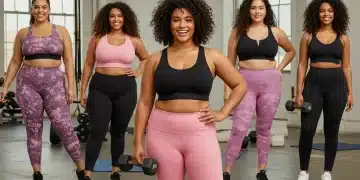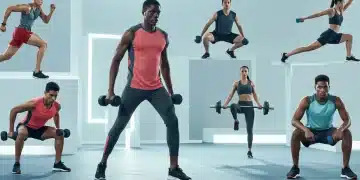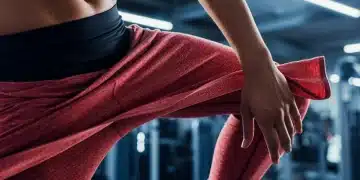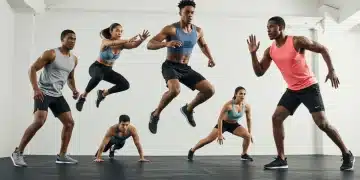Sweat-Wicking Technology: 3 Essential Features for 2025 Fitness Apparel

Anúncios
Advanced sweat-wicking technology features for 2025 fitness apparel are revolutionizing athletic wear by integrating enhanced moisture management, superior breathability, and eco-friendly durability, ensuring peak performance and comfort.
In the dynamic world of fitness and athletic performance, staying dry and comfortable is not merely a luxury; it’s a fundamental requirement for optimal results and enjoyment. As we look towards 2025, the evolution of sweat-wicking technology features in fitness apparel continues to push boundaries, promising even greater advancements for athletes and active individuals alike. This deep dive will explore the three essential features poised to redefine performance wear.
Anúncios
the science behind sweat-wicking: how it works
Understanding how sweat-wicking technology functions is crucial to appreciating its impact on fitness apparel. At its core, sweat-wicking is the fabric’s ability to pull moisture—sweat—away from the skin and move it to the fabric’s outer surface, where it can evaporate quickly. This process helps regulate body temperature, preventing the discomfort of damp clothing and the potential for chafing or skin irritation.
Traditional cotton, for example, absorbs moisture and holds it against the skin, leading to a heavy, clammy feeling. In contrast, modern sweat-wicking fabrics are engineered at a microscopic level. They typically feature synthetic fibers like polyester, nylon, or blends, which are inherently hydrophobic, meaning they repel water. These fibers are often woven or knitted in specific patterns that create capillary action, drawing moisture through tiny channels.
microscopic fiber structures and capillary action
The magic of sweat-wicking lies in the intricate design of the fabric’s fibers and weave. Imagine thousands of tiny straws working in unison, pulling liquid from one end to the other. This is essentially what happens with capillary action in these advanced textiles.
Anúncios
- Hydrophobic Fibers: Most sweat-wicking garments utilize synthetic materials that naturally resist water absorption.
- Capillary Channels: The unique weave creates microscopic pathways that draw moisture away from the skin.
- Surface Evaporation: Once sweat reaches the fabric’s outer layer, it spreads out, increasing the surface area for rapid evaporation.
- Temperature Regulation: By facilitating quick evaporation, the fabric helps cool the body, preventing overheating.
The development of these specialized fibers and construction methods has been a game-changer for athletic performance. By keeping the skin dry, athletes can maintain a more consistent body temperature, reduce energy expenditure on cooling, and ultimately perform better for longer periods. This foundational understanding sets the stage for exploring the specific features that will dominate in 2025.
In summary, the effectiveness of sweat-wicking technology hinges on its ability to manage moisture through engineered fabric structures. This fundamental principle ensures that whether you’re engaging in high-intensity training or a casual jog, your apparel works with your body to maintain optimal comfort and performance, laying the groundwork for the innovations we expect to see in the coming years.
feature 1: enhanced multi-directional moisture transfer
As we advance towards 2025, one of the most critical developments in sweat-wicking technology features is the optimization of multi-directional moisture transfer. Early sweat-wicking fabrics were effective at moving moisture away from the skin in a singular direction. However, the next generation of athletic wear focuses on a more sophisticated, holistic approach to moisture management, ensuring sweat is wicked away efficiently from all points of contact.
This enhanced capability means that no matter how an athlete moves or where sweat accumulates, the fabric actively pulls it away. This is achieved through innovative fabric constructions that integrate varying fiber densities and weave patterns across different zones of a garment. For instance, areas prone to higher perspiration, such as the back or underarms, might feature more aggressive wicking structures, while other areas maintain optimal breathability without over-wicking.
zoned wicking and intelligent fabric mapping
The concept of zoned wicking takes moisture management to a new level. Instead of a uniform fabric, designers are now ‘mapping’ the human body’s thermal and sweat zones to apply specific fabric technologies where they are most needed. This intelligent design ensures maximum efficiency and comfort.
- Targeted Sweat Zones: Fabrics are engineered with varying wicking capacities in areas like the back, chest, and underarms.
- Seamless Transitions: Advanced knitting techniques allow for smooth integration of different fabric structures, minimizing seams and potential irritation.
- Adaptive Performance: Garments can adapt to different levels of activity, maintaining comfort whether the wearer is at peak exertion or cooling down.
The result is a garment that feels like a second skin, actively managing moisture without feeling heavy or restrictive. This multi-directional transfer is not just about keeping you dry; it’s about maintaining a stable microclimate around your body, which is vital for sustained performance and overall well-being during any physical activity. The ability to precisely control moisture movement across the entire garment represents a significant leap in functional apparel design.
In essence, enhanced multi-directional moisture transfer is about creating a smarter garment that understands and responds to the body’s needs in real-time. This sophisticated approach ensures that athletes remain dry and comfortable, regardless of the intensity or duration of their workout, marking a significant evolution in how fitness apparel supports peak performance.
feature 2: superior breathability and airflow integration
Beyond simply moving sweat, the second essential feature revolutionizing sweat-wicking technology features for 2025 is the integration of superior breathability and optimized airflow. While wicking pulls moisture away, breathability allows air to circulate, facilitating the evaporation process and providing a cooling effect. The combination of both is paramount for true comfort and performance, especially in high-intensity activities or warmer climates.
Next-generation fabrics are designed with advanced porous structures and ventilation channels that maximize air exchange without compromising the fabric’s integrity or durability. This isn’t just about mesh panels; it involves microscopic perforations, open-knit structures, and even strategically placed vents that work in concert with the body’s natural cooling mechanisms. The goal is to create a constant flow of air that helps dissipate heat and accelerate sweat evaporation, keeping the wearer feeling fresh and light.

dynamic ventilation systems and intelligent fabric design
The future of fitness apparel will feature dynamic ventilation systems that respond to the wearer’s activity levels and environmental conditions. This intelligent design ensures that breathability is optimized precisely when and where it’s needed most.
- Micro-Perforation Technology: Tiny, laser-cut holes allow for maximum airflow without affecting fabric strength.
- Open-Knit Construction: Specialized knitting patterns create areas of increased permeability, promoting ventilation.
- Body-Mapped Ventilation: Airflow channels are strategically placed in high-heat zones to enhance cooling.
- Lightweight Materials: Ultra-lightweight fabrics contribute to an overall sense of airiness and reduce thermal burden.
These innovations ensure that the air can easily pass through the fabric, carrying away heat and moisture vapor. This constant air exchange not only enhances the evaporation of sweat but also directly cools the skin, preventing the build-up of stifling heat that can lead to discomfort and reduced performance. The synergy between wicking and breathability is what truly elevates these garments.
Ultimately, superior breathability and airflow integration mean that fitness apparel in 2025 will feel lighter, cooler, and more responsive to the body’s thermal needs. This advanced approach to ventilation is crucial for athletes seeking to push their limits while remaining comfortable and focused on their training.
feature 3: eco-conscious and durable material innovation
The third essential feature shaping sweat-wicking technology features for 2025 is the increasing emphasis on eco-conscious and durable material innovation. Consumers are not only demanding high-performance apparel but also garments that are sustainably produced and built to last. This dual focus drives manufacturers to explore new materials and manufacturing processes that minimize environmental impact without sacrificing performance.
The industry is moving towards recycled synthetics, bio-based polymers, and innovative blends that offer the same, if not superior, wicking and breathability properties as traditional materials. Furthermore, durability is being redefined to mean not just resistance to wear and tear, but also resistance to degradation from repeated washing, sun exposure, and rigorous activity. This ensures a longer lifespan for garments, reducing the need for frequent replacements and contributing to a more sustainable consumption cycle.
recycled fibers, bio-based materials, and enhanced longevity
The push for sustainability is leading to exciting advancements in material science, offering environmentally friendly alternatives that perform exceptionally well.
- Recycled Polyester and Nylon: Utilizing post-consumer plastic waste to create high-performance fibers, reducing landfill burden.
- Bio-Based Polymers: Developing materials from renewable resources like corn or sugarcane, lessening reliance on fossil fuels.
- Enhanced Fiber Strength: Engineering fibers for increased tensile strength and abrasion resistance, prolonging garment life.
- Dyeing Innovations: Exploring water-saving and chemical-reducing dyeing techniques to minimize environmental footprint.
These sustainable innovations extend beyond just the raw materials. Manufacturers are also focusing on closed-loop production systems, where waste is minimized and resources are reused. This holistic approach to sustainability ensures that the entire lifecycle of the garment, from production to disposal, is considered.
Moreover, enhanced durability contributes directly to sustainability by extending the usable life of activewear. Consumers can invest in high-quality items that withstand the rigors of intense training and frequent washing, reducing textile waste. This balance of performance, environmental responsibility, and longevity is becoming a defining characteristic of premium fitness apparel.
In conclusion, eco-conscious and durable material innovation is not just a trend but a fundamental shift in the design and production of sweat-wicking apparel. It reflects a growing awareness of environmental responsibility while continuing to meet the high-performance demands of the modern athlete, ensuring that fitness fashion aligns with a healthier planet.
the integration of smart textiles and sensory feedback
Looking ahead to 2025, the convergence of sweat-wicking technology features with smart textiles and sensory feedback is set to revolutionize fitness apparel. This goes beyond passive moisture management, entering an era where clothing actively interacts with the wearer, providing real-time data and adaptive comfort. Imagine fabrics that not only wick sweat but also measure your hydration levels or adjust their thermal properties based on your body temperature and external conditions.
The integration of micro-sensors directly into the fabric allows for continuous monitoring of various physiological parameters. These sensors, seamlessly woven into the textile, can track sweat rate, skin temperature, and even electrolyte loss, transmitting data to a connected device. This personalized feedback empowers athletes to optimize their performance, prevent dehydration, and make informed decisions about their training and recovery strategies.
wearable biosensors and adaptive thermal regulation
The next generation of smart athletic wear will feature embedded biosensors and materials capable of dynamic response.
- Real-time Hydration Monitoring: Sensors can detect sweat composition and volume, alerting athletes to dehydration risks.
- Integrated Thermoregulation: Fabrics with phase-change materials can absorb or release heat as needed, maintaining optimal skin temperature.
- Performance Analytics: Data collected from smart apparel can provide insights into exertion levels and recovery needs.
- Enhanced Safety: Monitoring vital signs and environmental factors can contribute to safer training practices.
This level of integration transforms apparel from a mere covering into an intelligent training partner. The data collected from these smart textiles can be invaluable for coaches, sports scientists, and individual athletes looking to gain a competitive edge. The fabrics themselves are designed to be washable and durable, ensuring the embedded technology withstands the rigors of athletic use.
The ultimate goal is to create a seamless experience where the apparel enhances performance through both physical comfort and actionable insights. This feature pushes the boundaries of what fitness clothing can achieve, moving beyond simple moisture management to a comprehensive system that supports the athlete’s entire physiological ecosystem.
In conclusion, the fusion of sweat-wicking with smart textiles and sensory feedback represents a significant leap forward. It promises a future where fitness apparel is not just functional but intelligently responsive, providing a holistic approach to athletic performance and well-being.
design and aesthetics: balancing function with style
While performance remains paramount, the aesthetic appeal and design versatility of sweat-wicking technology features in fitness apparel are equally crucial for 2025. Modern athletes and fitness enthusiasts demand garments that not only perform exceptionally but also look fashionable and align with their personal style. The industry is responding by seamlessly integrating advanced functionalities into sleek, stylish designs, blurring the lines between athletic wear and everyday fashion.
This balance is achieved through innovative fabric treatments that allow for a wider range of colors, textures, and finishes without compromising wicking capabilities or breathability. Designers are leveraging new printing techniques, sophisticated dyeing processes, and engineered knit patterns to create visually appealing garments that maintain their technical edge. The focus is on creating versatile pieces that can transition effortlessly from a high-intensity workout to a casual outing, reflecting the integrated lifestyle of today’s active consumer.
seamless construction, ergonomic cuts, and vibrant palettes
The aesthetic evolution of sweat-wicking apparel is characterized by thoughtful design elements that enhance both look and feel.
- Seamless Construction: Minimizing seams not only reduces chafing but also creates a cleaner, more streamlined silhouette.
- Ergonomic Cuts: Garments are tailored to move with the body, providing a flattering fit and unrestricted movement.
- Vibrant Color Palettes: Advanced dyeing techniques allow for richer, more durable colors that resist fading.
- Textural Variety: Blending different knit patterns and fabric finishes adds visual interest and tactile appeal.
The emphasis on design means that athletic wear is no longer confined to the gym. It has become a staple of casual and athleisure wardrobes, driven by the desire for comfort and functionality in all aspects of life. Manufacturers are investing in design teams that understand both textile engineering and current fashion trends, ensuring that their products are at the forefront of both performance and style.
This integration of function and fashion is vital for market appeal. Consumers want to feel confident and look good while pursuing their fitness goals, and 2025 apparel will deliver on this promise. The ability to combine high-tech features with desirable aesthetics ensures that sweat-wicking garments remain relevant and attractive to a broad audience.
In conclusion, the synergy between design and aesthetics with advanced sweat-wicking technology ensures that fitness apparel for 2025 will be as visually appealing as it is functionally superior. This holistic approach caters to the modern consumer’s desire for performance wear that seamlessly integrates into their lifestyle.
future outlook: personalized and adaptive sweat-wicking solutions
The future of sweat-wicking technology features extends beyond the innovations we’ve discussed, moving towards highly personalized and adaptive solutions by 2025 and beyond. Imagine apparel that not only wicks sweat but is custom-designed to your unique physiological profile and activity patterns. This level of personalization will transform the way we think about fitness wear, making it an even more integral part of individual performance optimization.
Advancements in 3D body scanning and additive manufacturing (3D printing) are paving the way for custom-fit garments that perfectly match an individual’s body shape, ensuring optimal contact for wicking and maximum comfort. Furthermore, AI-driven analytics will process data from wearable sensors to suggest personalized apparel adjustments or even predict performance needs based on historical data and real-time conditions.
custom-fit apparel and AI-driven performance optimization
Personalization will be at the forefront of future sweat-wicking solutions, offering unprecedented levels of comfort and efficiency.
- 3D Body Mapping: Creating garments that precisely fit an individual’s contours for superior wicking and reduced chafing.
- Additive Manufacturing: 3D printing textiles with customized ventilation patterns and wicking structures based on personal needs.
- AI-Powered Recommendations: Algorithms suggesting specific apparel features or materials based on an athlete’s sport, environment, and physiological data.
- Modular Apparel Systems: Customizable components that can be interchanged to adapt to varying weather conditions or activity types.
This hyper-personalized approach means that athletes will no longer rely on generic sizing or one-size-fits-all technology. Instead, their apparel will be an extension of their body, finely tuned to support their specific requirements. This not only enhances performance but also significantly improves the overall experience of physical activity.
The integration of AI and advanced manufacturing techniques will allow for rapid prototyping and production of these bespoke garments, making personalized fitness apparel more accessible. This shift represents a paradigm change, moving from mass-market production to individualized solutions that truly cater to the unique demands of each athlete.
In conclusion, the future of sweat-wicking technology is bright, promising highly personalized and adaptive solutions that will redefine comfort and performance in fitness apparel. This evolution underscores a commitment to innovation that truly puts the individual athlete at the center of design and technology.
| Key Feature | Brief Description |
|---|---|
| Multi-Directional Moisture Transfer | Advanced fabrics pull sweat from all contact points, using zoned wicking for efficient evaporation. |
| Superior Breathability & Airflow | Optimized ventilation, micro-perforations, and open-knit designs for enhanced cooling and comfort. |
| Eco-Conscious & Durable Materials | Use of recycled/bio-based fibers and enhanced strength for sustainability and extended garment life. |
| Smart Textile Integration | Embedded sensors for real-time physiological data and adaptive thermal regulation. |
frequently asked questions about sweat-wicking technology
The primary benefit is keeping the wearer dry and comfortable by pulling moisture away from the skin to the fabric’s surface for rapid evaporation. This helps regulate body temperature, prevents chafing, and enhances overall performance during physical activity.
Multi-directional fabrics feature advanced constructions with varying fiber densities and weave patterns, allowing sweat to be wicked away efficiently from all points of contact and specific sweat zones, unlike older, more uniform materials.
While sweat-wicking moves moisture, breathability allows air to circulate, facilitating faster evaporation and providing a cooling effect. The combination dissipates heat and moisture vapor effectively, crucial for comfort during intense workouts.
Yes, advancements mean eco-conscious materials like recycled synthetics and bio-based polymers now offer comparable or superior wicking and breathability. They also focus on enhanced durability, contributing to sustainability without compromising performance.
Smart textiles integrate micro-sensors to provide real-time physiological data, such as sweat rate and skin temperature. This allows for personalized feedback and adaptive comfort, transforming apparel into an intelligent training partner for optimized performance.
conclusion
The evolution of sweat-wicking technology in fitness apparel for 2025 is clearly driven by a trifecta of innovation: enhanced multi-directional moisture transfer, superior breathability and airflow integration, and a strong commitment to eco-conscious and durable material development. These essential features, coupled with the emerging integration of smart textiles and a keen eye on aesthetics, promise a future where athletic wear is not merely functional but intelligently responsive, environmentally responsible, and supremely comfortable. As consumers continue to seek performance and style, these advancements ensure that fitness apparel will not only meet but exceed expectations, supporting every stride, lift, and stretch with unparalleled efficacy.





